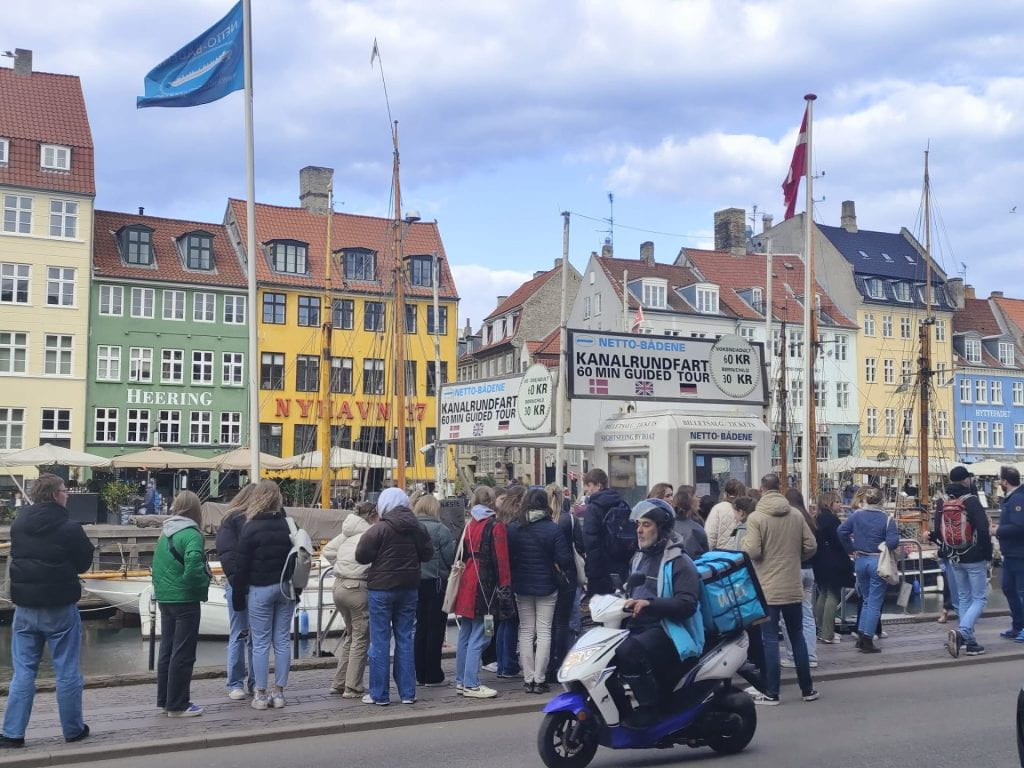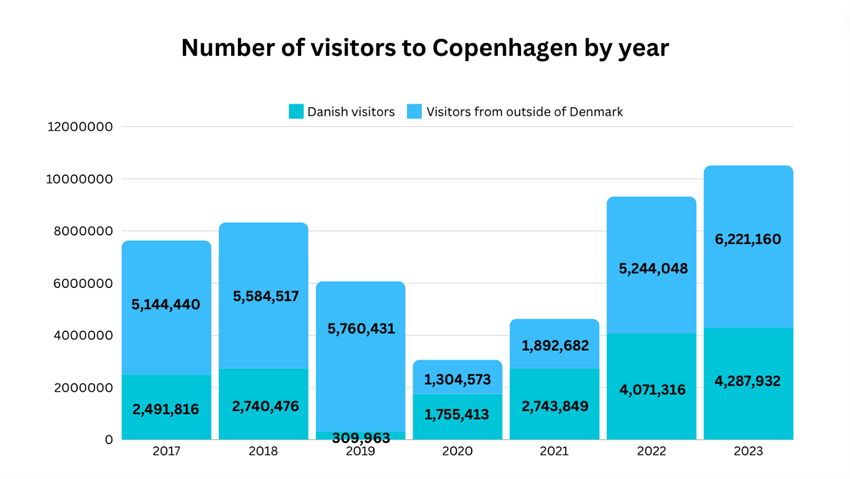More than 75% of locals see tourism positively, but find problems with visitors in transportation

Tourists waiting to go on a boat tour in Nyhavn, Copenhagen (Photo: Helen Chen)
By Helen Chen and Emma Monrós Rosell
In 2023, Copenhagen welcomed more than 10 million visitors, a number that is almost double the amount of the entire Danish population.
A quick look into past data would also indicate that the number of visitors has been on a continuously climbing trend, with exceptions of 2020 and 2021 due to COVID-19.

Number of Danish and international visitors to Copenhagen by year (data source: Visit Denmark)
The real concern of Copenhageners: bikes
In November and December 2023, Epinion, a Danish analysis and consulting company surveyed 8130 Danes about their attitudes towards tourism. They found that despite the large number of tourists, 78% of Danes believe that there are more positive than negative consequences for Denmark.
How Danes feel about tourism (data source: Epinion & Visit Denmark)
Liv Burmeister is a local Copenhagener who works at one of the many canal boat tour companies near Nyhavn. When asked about how she feels about the rise in tourists in Copenhagen, she says: “Although it is annoying at times and it gets crowded, especially in the inner city in the summer, I don’t see it as negative because it does boost the economy, and it has given me a job.”
The real concern of Copenhageners: bikes
The same survey by Epinion also investigated the specific issues faced by Danes who report that they experience problems with tourism. Among them, 91% report issues in relation to increased traffic, and 87% report general traffic issues.
In Copenhagen, a large part of the traffic issues is related to bikes.
When asked her about what annoys her a local in Copenhagen, Liv jokingly replied: “You’ll get the same answer if you ask anyone here on the street. The worst part about tourists in Copenhagen is tourists on bikes.”
According to her, Danes have a large bicycle culture, which also means a lot of road rules to follow such as signaling a turn. But when tourists rent bikes, they don’t always know or follow the rules, which makes it annoying and dangerous for locals.
Renting fares at a bike renting company in Copenhagen (Photo: Emma Monrós)
Dragan Krebs works at a bike rental shop in central Copenhagen. When asked if the shop gives instructions to people regarding biking, he said that generally they don’t. He added that “when they have kids, I mention it.”
In terms of safety, he said “We have the mandatory law like two breaks, a bell, and lights at night so all the bikes get that.” He also said that the shop does not make tourists wear mandatory helmets since it’s not mandatory by law. “I would highly recommend that kids wear helmets, though. And kids’ helmets are free at the shop,” was his personal input on the matter.
The future of tourism in Copenhagen: sustainability
Tourism in Copenhagen is predicted to have a 60% growth until 2025, according to National Tourism Strategy. With the data provided by different institutions, and seeing how tourism dynamics are developing in other major European cities, the official tourism organization Wonderful Copenhagen decided to drive tourism towards a more sustainable direction.
The organization was founded in 1992 and is a mix of contributions from private businesses and public institutions, like the Ministry of Industry. Through their sustainability strategy Tourism for Good they plan to ‘boldly expand tourism without harming the city’s culture or environment’.
They tried to broaden the city’s geographical interests for tourists outside of the most centric areas like Indre By, where most of the residents have a more negative view on tourism than the average in the Danish capital.
In 2022, Wonderful Copenhagen published their sustainability report where an increase in bed nights outside of the city of Copenhagen had increased; related to their action on broadening and promoting the use of more sustainable transport.
But apart from a better distribution of tourists in the area, the organization also has an environmental sustainability strategy.
According to a research by Nature, tourism related activity accounts for 8% of global carbon emissions, and the number is expected to rise.
Wonderful Copenhagen aims to have the great majority of hotels and convention venues to have a sustainability certification. Although 100% of large venues meet the requirement, hotels are still far from that target.
In 2023, Copenhagen ranked 3 in the Global Destination Sustainability Index just after Gothenburg and Oslo. But despite the good rankings and the marketing plans and guides created to promote sustainable visits to the Danish capital, some questions arise when the sustainability of tourism is concerned.
Tourists waiting to go on a boat tour in Nyhavn, Copenhagen. (Photo: Helen Chen)
Travelers’ consumption behaviours tend to an over-use of natural resources; but that is not the only problem.
Chains of tourism globally create social issues when an increasing tourism activity pushes prices of goods and services up, having an impact on residents’ expenditures. In addition, an increase in tourism can bring loss of the area’s cultural identity, adapting to visitors’ requirements rather than catering for locals’ needs.
Strategies like the ones created by Wonderful Copenhagen help to develop tourism sustainably and can be a guide in other cities; but it is still difficult for the negative effects of tourism to be fully diminished.
This article is for a general audience in Spain for the media EL PAÍS (https://elpais.com/) under the “International” section.


